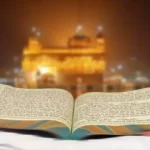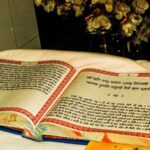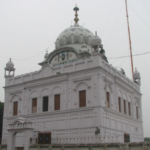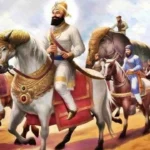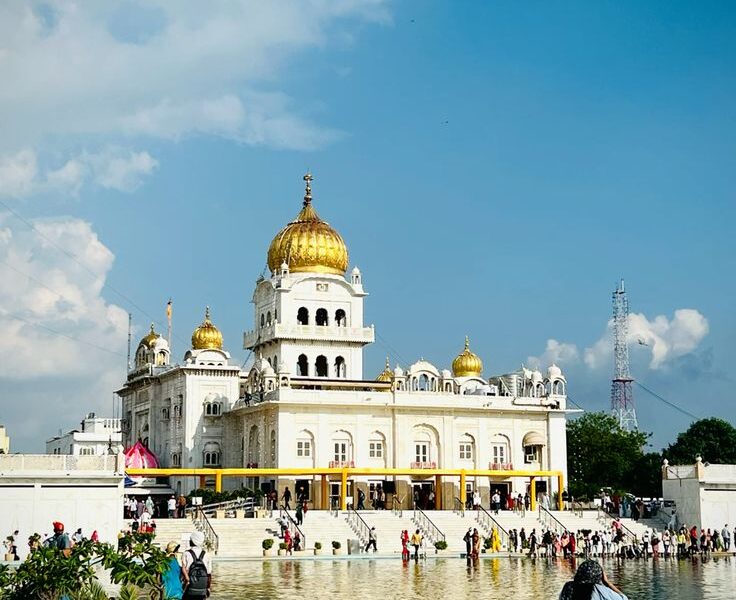The Guru Granth Sahib (Punjabi: pronounced [u nth sahb]) is the central holy religious document of Sikhism, regarded by Sikhs as the last, sovereign, and eternal Guru following the lineage of the religion’s ten human gurus. The first rendition, the Adi Granth (Punjabi: ), was compiled by the fifth guru, Guru Arjan (1564–1606). Its compilation was finished on August 29, 1604, and it was initially installed inside the Golden Temple in Amritsar on September 1, 1604. Baba Buddha was named the Golden Temple’s first Granthi. Soon after, Guru Hargobind included Ramkali Ki Vaar. Guru Gobind Singh, the tenth Sikh guru, later added hymns of Guru Tegh Bahadur to the Adi Granth and confirmed the text as his successor. This second iteration became known as the Guru Granth Sahib, and it is also known as the Adi Granth.
The book is divided into 1,430 angs (pages) and 5,894 shabads (line compositions), all of which are lyrically interpreted and set to a rhythmic traditional north Indian classical music genre.
The majority of the text is divided into 31 main ragas, with each Granth raga further segmented based on length and author. The scriptural hymns are organized mostly by the ragas in which they are read. The Guru Granth Sahib is written in numerous languages, including Punjabi, Lahnda, Prakrits, Apabhramsa, Sanskrit, Hindi languages (Braj Bhasha, Awadhi, Kauravi, Bhojpuri), Sindhi, and Persian, in the Gurmukhi script. Copies in these languages are frequently referred to as Sant Bhasha.
Guru Nanak, Guru Angad, Guru Amar Das, Guru Ram Das, Guru Arjan, and Guru Tegh Bahadur were the primary authors of the Guru Granth Sahib. It also includes the teachings and practices of fourteen Hindu Bhakti movement sants (saints), including Ramananda, Kabir, and Namdev, as well as one Muslim Sufi saint, Sheikh Farid.
The vision of the Guru Granth Sahib is of a society founded on divine freedom, mercy, love, and justice, devoid of all forms of oppression. While the Granth acknowledges and respects Hindu and Islamic teachings, it does not suggest moral reconciliation with either of these religions. It is located in a Sikh gurdwara (temple). When entering such a temple, a Sikh customarily prostrates before it. In Sikhism, the Granth is considered the eternal gurban and the spiritual authority.
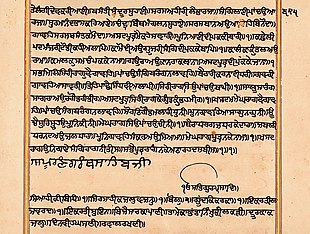
Guru Nanak wrote hymns that his devotees sang in rga adapted to the melody.
Guru Angad, his successor, established centers and distributed these hymns. The congregation would sing hymns as his operatives collected donations. The third and fourth gurus carried on this tradition as well. Guru Arjan, the fifth guru, found that Prithi Chand, his eldest brother and a competing contender to the Sikh guruship, possessed a copy of an earlier pothi (palm-leaf book) with hymns and was distributing hymns of the previous gurus alongside his hymns. Guru Arjan dismissed these as forgeries and became preoccupied with compiling a real anthology of acceptable hymns.
Guru Arjan began creating a Sikh community-approved translation of the sacred scripture. He sent his companions across the Indian subcontinent to gather the circulating hymns of Sikh gurus and persuaded Mohan, the son of Guru Amar Das, to offer him the collection of the first three gurus’ religious works in a humble manner by singing the hymns recorded in Guru Granth Sahib, 248. With Bhai Gurdas as his scribe, Guru Arjan picked and edited the hymns for inclusion in the Adi Granth as his colleagues returned with their collections. This work resulted in several draughts and manuscripts, some of which have survived to the present day.
The Guru Nanak Dev University Manuscript 1245, dated around 1599, is the oldest surviving manuscript form of the Adi Granth. Other early copies of the Adi Granth with minor differences include the Bahoval pothi (around 1600), Vanjara pothi (circa 1601), and Bhai Rupa pothi (circa 1601). (c. 1603).
Another early variant manuscript, known as the Guru Harsahai pothi, was saved by Sodhi and is thought to be the one that existed before Guru Arjan’s compilation and was given to his eldest brother Prithi Chand. It was originally installed in Amritsar, then relocated in the 18th century, and kept at Guru Harsahai (35 kilometers west of Faridkot, Punjab) until 1969, when the state government requested that it be displayed for the 500th-anniversary festivities. For the first time in almost 200 years, it was relocated and briefly displayed in Patiala for the occasion. Following that, the Sodhi’s agreed to transfers. This early edition of the Adi Granth manuscript, however, was stolen in 1970 during another similar transfer. Photos of certain pages, however, have survived.
Editions
A folio from a manuscript copy of the Guru Granth Sahib from the early nineteenth century (Schoyen Collection Norway)
Guru Arjan formally certified the first edition of the Sikh text, Adi Granth, in 1604. It was established at the Golden Temple, and the first granthi, or reader, was Baba Buddha. Guru Hargobind, Guru Har Rai, and Guru Har Krishan did not add any hymns. Guru Hargobind is credited with contributing the raga tunes for nine of the 22 Vars in the Sikh tradition. After IX Guru Tegh Bahadur’s beheading in Delhi, his son and successor Guru Gobind Singh added his hymns to the canon.

